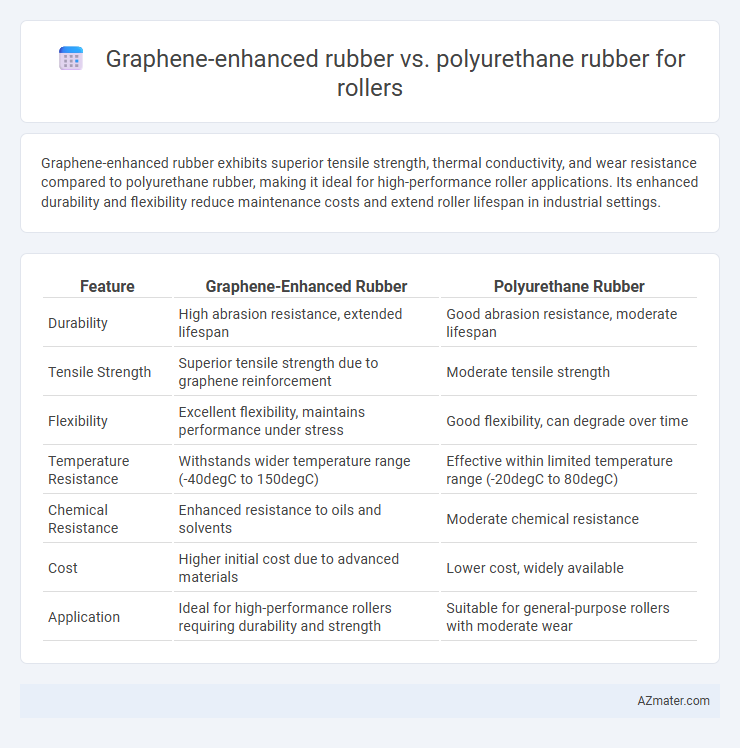Graphene-enhanced rubber exhibits superior tensile strength, thermal conductivity, and wear resistance compared to polyurethane rubber, making it ideal for high-performance roller applications. Its enhanced durability and flexibility reduce maintenance costs and extend roller lifespan in industrial settings.
Table of Comparison
| Feature | Graphene-Enhanced Rubber | Polyurethane Rubber |
|---|---|---|
| Durability | High abrasion resistance, extended lifespan | Good abrasion resistance, moderate lifespan |
| Tensile Strength | Superior tensile strength due to graphene reinforcement | Moderate tensile strength |
| Flexibility | Excellent flexibility, maintains performance under stress | Good flexibility, can degrade over time |
| Temperature Resistance | Withstands wider temperature range (-40degC to 150degC) | Effective within limited temperature range (-20degC to 80degC) |
| Chemical Resistance | Enhanced resistance to oils and solvents | Moderate chemical resistance |
| Cost | Higher initial cost due to advanced materials | Lower cost, widely available |
| Application | Ideal for high-performance rollers requiring durability and strength | Suitable for general-purpose rollers with moderate wear |
Introduction to Advanced Roller Materials
Graphene-enhanced rubber exhibits superior wear resistance, thermal conductivity, and mechanical strength compared to conventional polyurethane rubber in roller applications. The integration of graphene nanoparticles significantly improves elasticity and durability, enabling rollers to withstand higher loads and abrasive environments. Polyurethane rubber remains valued for its excellent chemical resistance and cost-effectiveness, but graphene-reinforced composites represent a cutting-edge advancement in roller material technology.
Overview of Graphene-Enhanced Rubber
Graphene-enhanced rubber offers superior mechanical strength, durability, and wear resistance compared to traditional polyurethane rubber used in rollers. The integration of graphene nanosheets significantly improves thermal conductivity and tensile strength, leading to longer service life and reduced maintenance costs. This advanced composite material also enhances elasticity and abrasion resistance, making it ideal for high-performance industrial roller applications.
Properties of Polyurethane Rubber
Polyurethane rubber offers exceptional abrasion resistance, high tensile strength, and excellent elasticity, making it ideal for roller applications requiring durability and flexibility. Its superior resistance to oils, chemicals, and weathering extends roller lifespan compared to standard rubber compounds. Enhanced load-bearing capacity and reduced deformation under stress contribute to consistent performance in industrial roller systems.
Mechanical Strength Comparison
Graphene-enhanced rubber demonstrates superior mechanical strength compared to polyurethane rubber used in rollers, exhibiting up to 30% higher tensile strength and improved abrasion resistance. The incorporation of graphene significantly enhances the composite's elasticity and durability under repeated stress, making it ideal for high-performance roller applications. In contrast, polyurethane rubber provides good flexibility but generally falls short in wear resistance and load-bearing capacity compared to graphene-reinforced alternatives.
Wear and Abrasion Resistance
Graphene-enhanced rubber exhibits significantly improved wear and abrasion resistance compared to polyurethane rubber, due to graphene's exceptional mechanical strength and nano-scale reinforcement properties. This enhancement leads to longer service life and reduced maintenance for rollers used in high-friction environments. Polyurethane rubber offers decent abrasion resistance but typically wears faster than graphene-enhanced composites under continuous heavy-duty applications.
Chemical and Environmental Durability
Graphene-enhanced rubber exhibits superior chemical resistance and environmental durability compared to polyurethane rubber, maintaining its mechanical properties under exposure to oils, solvents, and UV radiation. The presence of graphene nanosheets improves barrier properties, reducing chemical permeation and oxidative degradation, thus extending roller lifespan in harsh industrial environments. In contrast, polyurethane rubber, while flexible and abrasion-resistant, tends to degrade faster when exposed to aggressive chemicals and prolonged UV exposure.
Performance in Industrial Applications
Graphene-enhanced rubber exhibits superior tensile strength, abrasion resistance, and thermal conductivity compared to polyurethane rubber, making it ideal for high-wear industrial rollers. Its enhanced mechanical properties result in longer service life and reduced maintenance costs in demanding manufacturing environments. Polyurethane rubber, while flexible and impact-resistant, typically offers lower durability and heat dissipation efficiency under continuous heavy loads.
Cost and Economic Considerations
Graphene-enhanced rubber rollers offer significant cost savings through improved durability and extended service life, reducing replacement frequency compared to polyurethane rubber rollers. While the initial investment for graphene-enhanced rubber may be higher, the lower maintenance expenses and enhanced performance provide better long-term economic value. Polyurethane rubber rollers typically incur higher total cost of ownership due to faster wear and more frequent replacements, impacting overall operational budgets.
Sustainability and Environmental Impact
Graphene-enhanced rubber exhibits superior durability and reduced wear, leading to longer roller lifespans and less frequent replacements, which significantly decreases environmental waste compared to traditional polyurethane rubber. The incorporation of graphene reduces the need for toxic chemical additives commonly found in polyurethane production, thereby lowering the ecological footprint and improving recyclability. Graphene's ability to improve mechanical properties also enables energy-efficient manufacturing processes by reducing curing time and energy consumption relative to polyurethane rubber.
Future Trends in Roller Material Technology
Graphene-enhanced rubber offers superior wear resistance, thermal conductivity, and mechanical strength compared to polyurethane rubber, making it a promising option for next-generation roller materials. Future trends emphasize the integration of nanomaterials like graphene to improve roller durability and performance under high-stress industrial conditions. Research focuses on optimizing composite formulations to balance cost-effectiveness with enhanced physical properties, driving innovation in roller material technology.

Infographic: Graphene-enhanced rubber vs Polyurethane rubber for Roller
 azmater.com
azmater.com